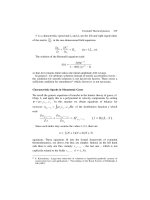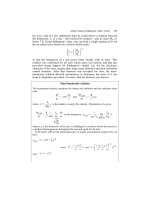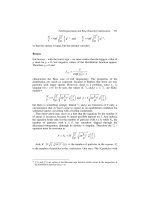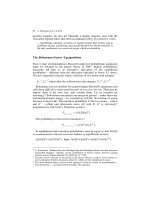Overview of energy consumption
Bạn đang xem bản rút gọn của tài liệu. Xem và tải ngay bản đầy đủ của tài liệu tại đây (649.36 KB, 5 trang )
$
EFFICIENCY
CONSERVATION
Energy Consumption
Energy Use
Think about how you use energy every day. You wake up to an alarm
clock. You take a shower with water warmed by a hot water heater.
You listen to music on the radio as you dress. You catch the bus to
school. That’s just the energy you use before you get to school! Every
day, the average American uses about as much energy as is stored
in seven gallons of gasoline. Energy use is sometimes called energy
consumption.
ENERGY USE BY SECTOR
Transportation
28%
Who Uses Energy?
The U.S. Department of Energy divides energy users into four groups:
residential, commercial, industrial, and transportation. These groups
are called the sectors of the economy.
22%
Commercial
Industry
19%
31%
Residential and Commercial Sector
Any place where people live is considered a residential building.
Commercial buildings include offices, stores, hospitals, restaurants,
and schools. Residential and commercial buildings are grouped
together because they use energy in the same ways—for heating
and cooling, lighting, heating water, and operating appliances.
Residential
Source: Energy Information Agency
Together, homes and buildings consume more than a third of
the energy used in the United States today. In the last 30 years,
Americans have reduced the amount of energy used in their homes
and commercial buildings. We still heat and cool rooms, and heat
hot water. We have more home and office machines than ever. Most
of the energy savings have come from improvements in technology
and in the ways the equipment is manufactured.
Heating oil is the third leading fuel used for home heating. In 1973,
the average home used 1,300 gallons of oil a year. Today, that figure
is about 800 gallons, a significant decrease. New oil furnaces burn oil
more cleanly and operate more efficiently.
Heating & Cooling
Lighting
It takes a lot of energy to heat rooms in winter and cool them in
summer. Half of the energy used in the average home is for heating
and cooling rooms. The three fuels used most often for heating are
natural gas, electricity, and heating oil. Today, more than half the
nation’s homes use natural gas for heating.
Most natural gas furnaces in the 1970s and 1980s were about 60
percent efficient. That means they converted 60 percent of the
energy in the natural gas into usable heat. New gas furnaces are
designed to be up to 98 percent efficient.
The second leading fuel for home heating is electricity. Electricity
also provides almost all of the energy used for air conditioning. The
efficiency of heat pumps and air conditioners has increased more
than 50 percent in the last 30 years.
44
In the future, we may see more use of renewable energy sources,
such as geothermal and solar energy, to heat and cool our homes
and workspaces.
Homes and commercial buildings also use energy for lighting. The
average home spends 10 percent of its electric bill for lighting.
Schools, stores, and businesses use about 38 percent of their
electricity for lighting. Most commercial buildings use fluorescent
lighting. It costs more to install, but it uses a lot less energy to
produce the same amount of light.
Most homes still use the type of light bulb invented by Thomas
Edison over 100 years ago. These incandescent bulbs are not very
efficient. Only about 10 percent of the electricity they consume is
converted into light. The other 90 percent is converted to heat.
Compact fluorescent light bulbs (CFLs) can be used in light fixtures
throughout homes. Many people think they cost too much to buy
(about $3 - $10 each), but they actually cost less overall because they
last longer and use less energy than incandescent bulbs.
Intermediate Energy Infobook
Appliances
Over the last 100 years, appliances have changed the way we
spend our time at home. Chores that used to take hours can
now be done in minutes by using electricity instead of human
energy. In 1990, Congress passed the National Appliance Energy
Conservation Act, which requires appliances to meet strict energy
efficiency standards. As a result of this Act, home appliances
have become more energy efficient. Water heaters, refrigerators,
clothes washers, and dryers all use much less energy today than
they did 25 years ago.
Appliance Efficiency Ratings
When you buy an appliance, you should pay attention to the
yellow EnergyGuide label on every appliance. This label tells you
the Energy Efficiency Rating (EER) of the appliance. The EER tells
how much it costs to operate the appliance.
LIGHTING EFFICIENCY
1879 Incandescent
escent
1.4
Today’s Incandescent
17
Today’s Halogen
LUMENS PER WATT
20
100
Today’s Fluorescent
REFRIGERATOR EFFICIENCY
Payback Period
Whether you buy a furnace, hot water heater, or other home
appliance, you must choose the best bargain. Since most highefficiency systems and appliances cost more than less efficient
ones, you have to know how much it will cost to operate the
appliance each year and how many years you can expect to use it.
The payback period is the amount of time you must use a system
or appliance before you begin to benefit from energy savings.
2,500 kwh
per year
2,000
For example, if you buy an efficient refrigerator that costs $100
more, but uses $20 less electricity each year, you would begin
saving money after five years. Your payback period would be five
years. Since refrigerators usually last ten years, you would save
$100 over the life of the appliance and save natural resources.
2,215 kwh
1,500
1,000
ENERGY GUIDE
500
0
537 kwh
REFRIGERATORS
MADE BEFORE 1980
2008 ENERGY STAR®
QUALIFIED
REFRIGERATORS
Source: ENERGY STAR®
The NEED Project
P.O. Box 10101, Manassas, VA 20108
1.800.875.5029
www.NEED.org
45
$
EFFICIENCY
CONSERVATION
Energy Consumption
Industrial Sector
The United States is a highly industrialized country. We use a lot of
energy. Today, the industrial sector uses 31 percent of the nation’s
energy. Since 1973, the industrial sector has grown by two-thirds,
but has used only 15 percent more energy to fuel that growth. Every
industry uses energy, but six energy-intensive industries use most of
the energy consumed by the industrial sector.
U.S. OIL REFINERY OPERATING EXPENSES
Personnel
16%
Petroleum Refining
The United States uses more petroleum than any other energy
source. Petroleum provides the U.S. with about 37 percent of the
energy we use each year. Petroleum can’t be used as it comes out of
the ground. It must be refined before it can be used.
Oil refineries use a lot of energy to convert crude oil into gasoline,
diesel fuel, heating oil, chemicals, and other products. Almost half
of a refinery’s operating costs (43 percent) is for energy. Refineries
today use about 25 percent less energy than they did in 1973.
Energy
43%
Other
17%
Maintenance
24%
Steel Manufacturing
The steel industry uses energy to turn iron ore and scrap metal into
steel. Hundreds of the products we use every day are made of steel.
It is a very hard, durable metal and it must be heated to very high
temperatures to manufacture it. Producing those high temperatures
takes a lot of energy. The cost of energy in the steel industry is 15 to
20 percent of the total cost of making the steel. Most of this energy
comes from coal, or electricity generated from coal.
The use of recycled steel also saves energy. It requires 33 percent
less energy to recycle steel than to make it from iron ore. Today, twothirds of new steel is made from recycled scrap, making steel the
nation’s leading recycled product.
Since 1973, the steel industry has reduced its energy consumption
by 45 percent per ton of steel. New technology has made steel
stronger so that less steel is needed for many uses. For example,
the Willis Tower, formerly the Sears Tower, in Chicago could be built
today using 35 percent less steel.
Aluminum is a very light-weight, versatile metal. We use aluminum to
make soft drink cans, food wrap, car parts, and many other products.
It takes huge amounts of electricity to make aluminum from bauxite,
or aluminum ore. The cost of electricity is 30 percent of the cost of
manufacturing aluminum.
STEEL PRODUCTION
Today, it takes 23 percent less electricity to produce a pound of
aluminum than it did 30 years ago, mainly because of recycling.
Using recycled aluminum requires about 95 percent less energy than
converting bauxite into metal.
Aluminum Manufacturing
Paper Manufacturing
The United States uses enormous amounts of paper every day—
newspapers, books, bags, and boxes are all made of paper.
Energy is used in every step of paper making. Energy is used to chop,
grind, and cook the wood into pulp. More energy is used to roll and
dry the pulp into paper. In 1973, the amount of energy needed to
make one ream (500 sheets) of copy paper was equal to 3.7 gallons
of gasoline.
Today, with advanced technologies, the energy used to make the
same amount of paper would equal just two gallons of gasoline.
The paper and pulp industry uses 42 percent less energy today,
mainly because of better technology. Many industries have lowered
46
Intermediate Energy Infobook
energy use by using recycled materials. In the paper and pulp
industry, it is not cheaper to use recycled paper because it costs
money to collect, sort, and process the waste paper.
REDUCTION IN ENERGY USE, 1975 – TODAY
Recycling has other benefits, though. It reduces the amount of
paper in landfills and means fewer trees must be cut.
25%
Chemical Manufacturing
Chemicals are an important part of our lives. We use chemicals in
our medicines, cleaning products, fertilizers and plastics, as well as
in many of our foods.
Petroleum Refineries
41%
Chemicals
45%
The chemical industry uses energy in two ways. It uses coal, oil, and
natural gas to power the machinery to make the chemicals. It also
uses petroleum and natural gas as major sources of hydrocarbons
from which the chemicals are made.
Steel
23%
42%
New technology has made the chemical industry 60 percent more
energy efficient than it was 30 years ago.
Aluminum
Paper & Pulp
33%
Cement
45% 40% 35% 30% 25% 20% 15% 10% 5% 0%
Cement Manufacturing
Some people think the United States is becoming a nation of
concrete. New roads and buildings are being built everywhere,
every day. We use lots of concrete.
Source: U.S. Department of Energy
PAPER RECYCLING
Concrete is made from cement, water, and crushed stone. A lot of
energy is used in making cement. The process requires extremely
high temperatures—up to 3,500 degrees Fahrenheit.
Cement plants have reduced their energy consumption by onethird using innovative waste-to-energy programs. More than half of
the cement plants in the U.S. now use some type of waste for fuel.
These wastes, such as printing inks, dry cleaning fluids and used
tires, have high energy content. For example, the energy content of
one tire equals that of two gallons of gasoline. This industry is using
energy that would otherwise be wasted in a landfill.
Image courtesy of National Renewable Energy Laboratory
The NEED Project
P.O. Box 10101, Manassas, VA 20108
1.800.875.5029
www.NEED.org
47
$
EFFICIENCY
CONSERVATION
Energy Consumption
Transportation Sector
The United States is a big country. The transportation sector uses
twenty-seven percent of the energy supply to moving people and
goods from one place to another.
The Automobile
Americans love automobiles. We love to drive them. We don’t want
anyone telling us what kind of car to buy or how much to drive it.
Thirty years ago, most Americans drove big cars that used a lot of
gas. The gas shortages of the 1970s didn’t change Americans’ driving
habits much. What did change was the way automobiles were built.
Automakers began making cars smaller and lighter. They built
smaller and more efficient engines.
One reason for the changes was that the government passed
laws requiring automobiles to get better gas mileage. With new
technologies, cars now travel more miles on each gallon of gas. Today,
passenger cars get an average of 30 miles per gallon. If automakers
hadn’t made these changes, we would be using 30 percent more fuel
than we do today.
In 1973, there were 102 million cars on the road. Today, there are
more than 135 million cars. There are more cars being driven more
miles than ever before. Almost half of the passenger vehicles sold
in 2008 were sport utility vehicles and light trucks. With the recent
fluctuations in fuel prices, however, demand for these big vehicles
has dropped, while demand for hybrids and other fuel efficient
vehicles has increased.
Commercial Transportation
Passenger cars consume about two-thirds of the fuel we use for
transportation. Commercial vehicles consume the rest. These
vehicles—trains, trucks, buses, and planes—carry people and
products all across this vast country. Commercial vehicles have also
become more fuel efficient in the last 30 years.
Trucks use more fuel than any other commercial vehicle. Almost
all products are at some point transported by truck. Trucks are big
and don’t get good gas mileage. They have diesel engines and can
travel farther on a gallon of diesel fuel than they could on a gallon
of gasoline. In the last thirty years, trucks have improved their gas
mileage from 4.8 miles per gallon to about seven miles per gallon.
Trains carry most of the freight between cities. In the last 30 years,
trains have improved their fuel efficiency by 60 percent. Trains are
lighter and stronger and new locomotives are more efficient.
Airplanes move people and products all over the country. In 2008,
more than 800 million passengers flew on planes. Airlines are
twice as efficient today as they were 30 years ago. Fuel is one of
the biggest operating costs for airlines. Making planes more energy
efficient is very important to airlines.
Mass Transit is public transportation for moving people on buses,
trains, light rail, and subways. Today, there are about eight billion
trips made on public transit systems. That sounds like a lot, but it
is less than the number of trips made in 1970. Why is this? One
reason is that Americans love their cars. Another is that people have
moved from cities to suburbs and many businesses have followed.
Most mass transit systems were designed to move people around
cities or from suburbs to cities. Very few systems move people from
suburb to suburb.
Most people worry about air pollution from auto exhaust. They also
worry about traffic congestion. Congress has passed legislation
supporting public transit. If public transit is convenient and the cost
is reasonable, people may leave their cars at home.
AVERAGE FUEL ECONOMY OF NEW PASSENGER CARS
35.0*
35 Miles per Gallon
30
28.0
28.5
1990
2000
31.2
24.3
25
20
15
13.4
10
5
0
1973
1980
2008
2020
*By 2020 new model cars and light trucks will have to meet a 35 mpg fuel economy standard.
Source: U.S. Department of Energy
48
Intermediate Energy Infobook









